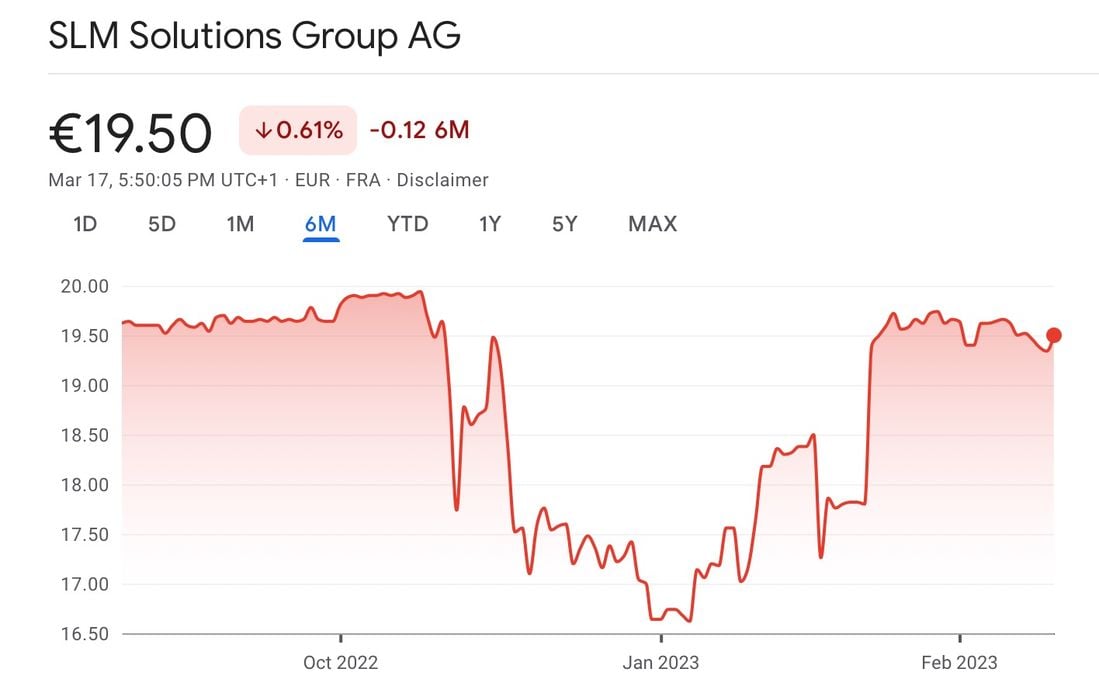
Once again we take a look at the valuations of the major 3D printing companies over the past week.
Publicly traded companies are required to post their financial reports, as well as appear on stock markets. From there we can calculate the total value of their company by multiplying the current stock price by the number of outstanding shares. This number is the market capitalization, and represents the current valuation of the company.
It’s a great number of compare companies, as the market capitalization can be leveraged to provide more capabilities for the company. Shares could, for example, be used as collateral for a loan. That and similar maneuvers could generate cash with which the company might undertake new projects.
In other words, “market cap”, as it is known, is quite important.
You might think it’s not important to monitor these companies each week, as their value is realized only when stocks are sold. However, events happen to companies occasionally that cause their value to rise and fall, and this weekly post is where we track such things.
Note that our list here does not include all major 3D print companies. Not all 3D print companies are publicly traded, and thus we cannot officially know their true size, such as EOS. Others, like HP or Siemens, have very large 3D printing divisions, but are part a much larger enterprises and we cannot know the true size of their 3D printing activities.
Let’s take a look at the 3D printing companies on this week’s list.
3D Printing Leaderboard
| RANK | COMPANY | CAP | CHG |
| 1 | 3D Systems | 1,312 | -30 |
| 2 | Stratasys | 1,011 | -19 |
| 3 | Protolabs | 827 | -46 |
| 4 | Xometry | 711 | -80 |
| 5 | Nano Dimension | 669 | -44 |
| 6 | Desktop Metal | 657 | -6 |
| 7 | SLM Solutions | 646 | +112 |
| 8 | Velo3D | 435 | -9 |
| 9 | Materialise | 434 | -45 |
| 10 | Markforged | 190 | -20 |
| 11 | FATHOM | 97 | -9 |
| 12 | Steakholder Foods | 45 | 0 |
| 13 | Massivit | 40 | -0 |
| 14 | Freemelt | 30 | -1 |
| 15 | Titomic | 21 | +0 |
| 16 | Shapeways | 20 | -1 |
| 17 | voxeljet | 17 | -1 |
| 18 | Sygnis | 12 | +0 |
| 19 | Sigma Additive Solutions | 11 | 0 |
| 20 | AML3D | 11 | +1 |
| 21 | Aurora Labs | 5 | +0 |
| 22 | Tinkerine | 1 | +0 |
| TOTAL | 7,202 | -199 |
This week saw a slight dip on the leaderboard of under three percent, mostly due to general market effects.
Of course, there were exceptions that we should discuss.
Xometry, the long time first-place holder on the leaderboard lost ten percent in value this week. This is likely a continuation of their very dramatic drop from the other week, when they lost almost half their value.

SLM Solutions gained an incredible 21% in value this week. While that would seem notable, it actually seems to be a recovery to previous levels in past months after a bit of a dip over the year end.
Finally, I wondered what would happen with the two companies in question from last week: Stratasys and Nano Dimension. As you may recall, the troubled Nano Dimension made an unsolicited offer to Stratasys to acquire the company using their war chest of US$1.1B cash. Moves of this sort will certainly push stock prices around, so what happened?
In the day after the offer last week, Nano Dimension’s value dropped, while Stratasys’ value rose. That indicates that the market felt that the offer was too low.
Last week we saw most company valuations drop due to market conditions, but Stratasys’ value didn’t drop as much as the average, while Nano Dimension’s dropped double the leaderboard average. Since the unsolicited offer, Nano Dimension’s valuation has dropped US$129M.
It seems likely Stratasys will reject the offer, or perhaps propose a far higher value to Nano Dimension. However, Nano Dimension is basically using their entire stash of cash on the proposal and doesn’t have more cash for an increased offer. That is, unless they generate more cash through a new public offering or side deals.
Nevertheless, Nano Dimension seems quite set on creating a new “Nano Stratasys”, as explained by Nano Dimension CEO Yoav Stern in a long video:
Stern had very strong things to say about current Stratasys management, which I cannot imagine would persuade them to accept the offer.
Stern explains that they intend to go directly to Stratasys individual shareholders with their offer, should the Stratasys board reject it. However, given the market behavior this week, I suspect the offer is likely too low for many, in spite of Stern’s explanation.
I’m also wondering why Nano Dimension, a company with US$1.1B in cash, is valued at only US$669M? Could not someone buy the entire company for that price, shut it down and empty the bank for a tidy US$400M instant profit? Also, Nano Dimension owns 14.5% of Stratasys, and that piece is currently worth US$145M and presumably part of Nano Dimension’s valuation of US$669M, separate from their own operations. Something seems very, very wrong here.
Upcoming Changes
A company set to appear was Essentium, who announced plans to use a SPAC-merger to launch on NASDAQ. However, that deal has been suspended so we’re wondering what the company’s next steps might be.
One company I’ve started to watch is ICON, the Texas-based construction 3D printer manufacturer. This privately-held company has been raising a significant amount of investment to the tune of almost half a billion dollars. At that level it is likely they will be discussing a transition to public markets at some point, which would certainly place them at or near the top of our leaderboard.
Another company that would seem logical to go public is VulcanForms, a manufacturing service using an advanced metal 3D printing process. They are currently privately valued at over US$1B, and going public could cause that to go even higher.
If you are aware of any other publicly-traded 3D print companies that should be on our leaderboard, please let us know!
Others In The Industry
While we’ve been following the public companies, don’t forget there are a number of private companies that don’t appear on any stock exchange. These privately-held companies likely have significant value, it’s just that we can’t know exactly what it is at any moment. The suspected bigger companies include EOS, Carbon and Formlabs.
Perhaps someday some of them will appear on our major players list.
Related Companies
Finally, there are a number of companies that are deeply engaged in the 3D print industry, but that activity is only a small slice of their operations. Thus it’s not fair to place them on the lists above because we don’t really know where their true 3D print activities lie.
